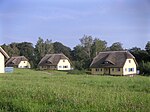Goor (Rügen)
Forests and woodlands of Mecklenburg-Western PomeraniaGeography of RügenPutbusVorpommern-Rügen geography stubs

The Goor is a woodland, seven hectares in area, on the German Baltic Sea island of Rügen near Lauterbach, a village in the borough of Putbus, which runs for about 1.5 km directly along the shore of the Bay of Greifswald. The woods of the Goor consist predominantly of beech and English oak. They are designated as a nature reserve and are popular with walkers.
Excerpt from the Wikipedia article Goor (Rügen) (License: CC BY-SA 3.0, Authors, Images).Goor (Rügen)
Fürst-Malte-Allee,
Geographical coordinates (GPS) Address Nearby Places Show on map
Geographical coordinates (GPS)
| Latitude | Longitude |
|---|---|
| N 54.344166666667 ° | E 13.511388888889 ° |
Address
Fürst-Malte-Allee 1
18581
Mecklenburg-Vorpommern, Germany
Open on Google Maps









